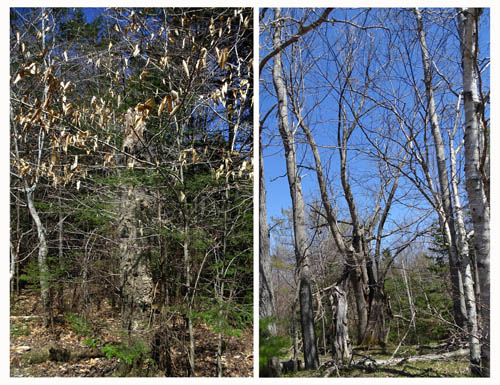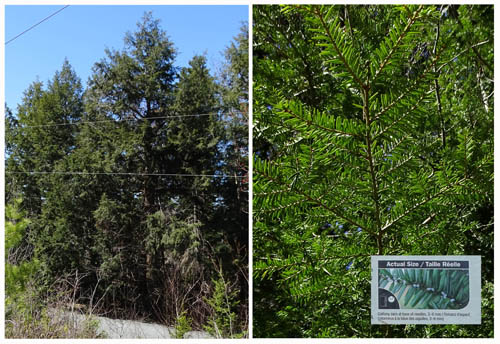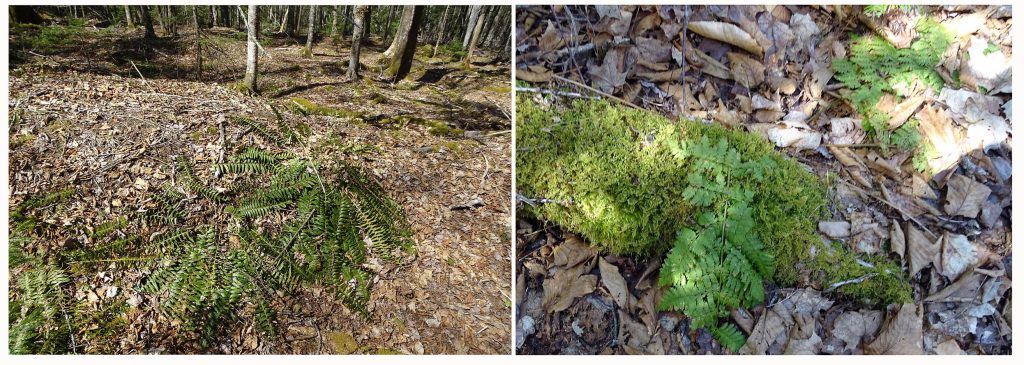Notes & Photos from Forest Walk at Sandy Lake Park, Sat Apr 27, 2024
– David P
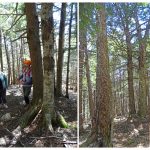 DIRT GANG FOREST WALK, pages DIRT GANG FOREST WALK, pages
– DirtGang Forest Walk Intro 21Apr2024 –> Forest Walk Apr 27, 2024 (THIS PAGE) |

Sandy Lake Park Beauty Participant Colleen Walsh Bouman put some of her pics from the event together in a video; it conveys a good sense of the place and the day. View (download) Video (.mov, 17 MB
Thx for sharing Colleen!!!
CONTENTS OF THIS PAGE
1. Intro
2. The Route
3. Park Entrance to the Big Parking Lot
4. Big Parking Lot to the Beach
5. On to the Drumlin
6. The Old Hardwood-dominated mixed Forest
On a separate page: Sean H on lichens, mosses & liverworts
1. Intro
Field Trip Guides: Sean Haughian (Curator of Botany, NS Museum) & David Patriquin (Dal Biology prof, retired).
Handout: DP’s Notes on Forests of Sandy Lake & Environs (Bedford) (2 pages)
It was a rapid-fire intro to the area and the plants. I am hoping these photos and notes can be of help to those who wish to go back to the area and have a second look at a more leisurely pace; and to others who might wish to explore the area on their own.
We followed my now standard route for a ‘Sandy Lake Forest Walk’. It’s an easy walk for the most part, roughly 2.7 km in total. This particular event was scheduled as a 2-hr walk (1-3 p.m.) and while that’s readily achievable walking-wise, 3 even 4 hours are required if one wants to spend significant time exploring particular areas, ID ing plants etc. or perhaps doing some ‘Forest Bathing’.
We viewed and talked about forest ecology and the trees and shrubs, ferns and herbs and the “little plants”- the mosses, lichens and liverworts (Sean’s specialty) – along the way; the last of us were back at the gate at 5 p.m.
2. The Route
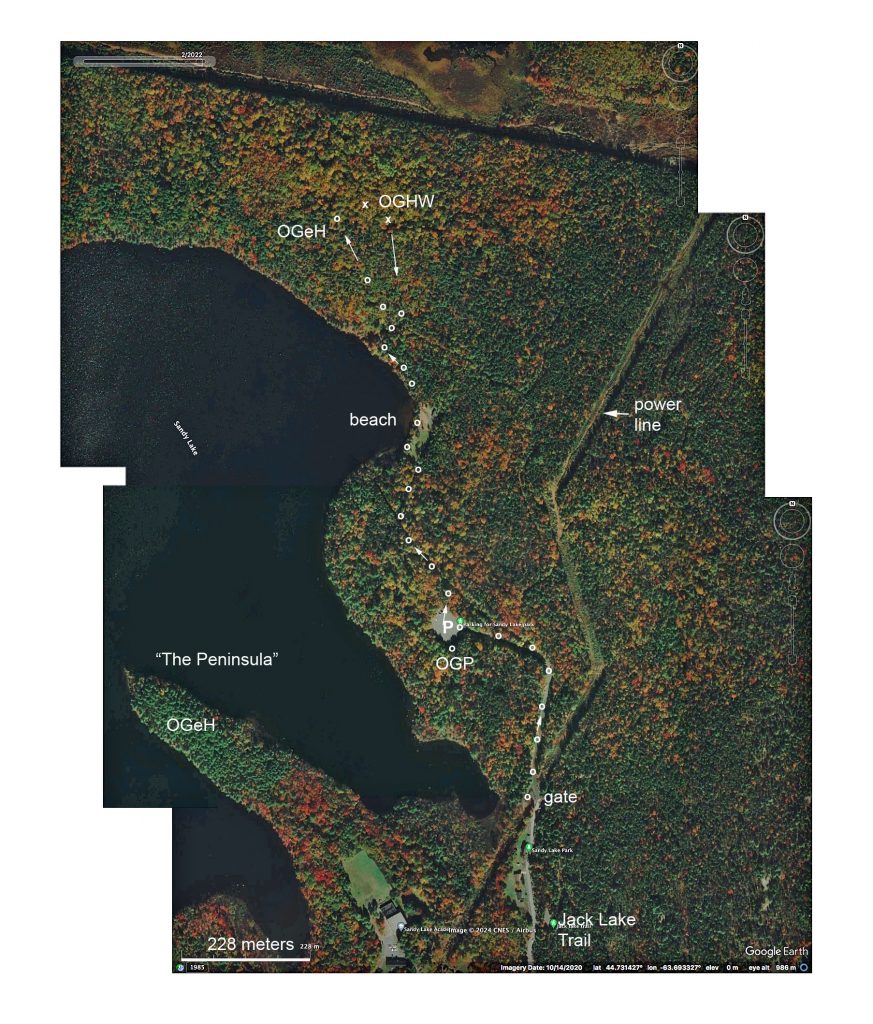
Google Earth image showing route. Click on image for larger version. OG sites are patches of Old Growth that we visited; OGP= Pine-dominated; OGeH= Eastern Hemlock dominated; OGHW= Hardwoods dominant. Deciduous Trees (bright fall colours) and evergreen trees (green) are distinguishable in this Google Earth image taken on Oct 14, 2020. The entrance to Sandy Lake Beach Park is at the “Gate”; there is a small parking lot there. The gate is open during daylight hours May 1 to Oct 1 which allows vehicle access to “P”, the “Big Parking Lot”. The Jack Lake Trail is a popular walking route, somewhat rough; there is a parking lot by the entrance. The power line is also a route for walking; it is not maintained, there are muddy spots etc.
3. Park Entrance to the Big Parking Lot
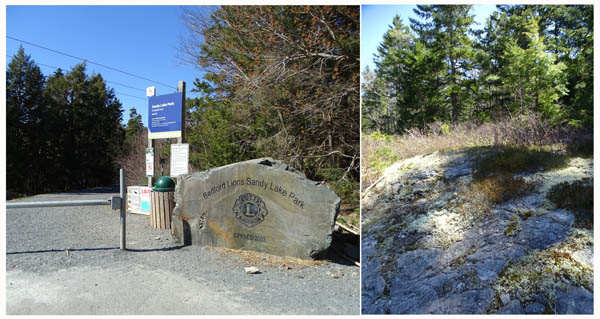
Left: Park entrance. The gate is open May 1 to Oct 1. Right: A patch of Broom Crowberry/LichenBarrens on the Power line cut, close to park entrance. Photos on Apr 27, 2024.
We had expected the gate to have beeb opened for us but it wasn’t; I left a note on my car, which was parked next to the gate, asking participants to walk down to the Big Parking Lot; no one saw it, so participants assembled by the Gate. As people arrived, Norris Whiston handed out colour prints of his Cobequid Mountain Field Guide to Ferns, Club Mosses, Mosses and Lichens, Thx Norris for a very thoughtful and generous contribution. View more of Norris’s Guides under NW Guides & Keys on the NS Wild Flora Society website.
Sean Haughian arrived (on a bike!) – his second City Nature Challenge event of the day, and spent about 20 minutes with the group on a patch of barrens by the gate. He picked up some pieces of lichen and a clump of Sphagnum moss and talked about their structure and ecological significance; Sean carefully put back the clump of Sphagnum moss before moving on!
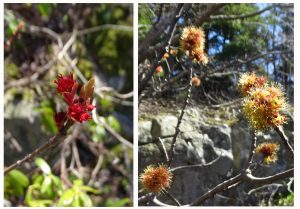
Red Maples are “dioecious”: some plants are female (left) and some male (right). Photos are of flowers on adjacent trees close to the gate.
Apr 27, 2024
I met the group at that point and we walked down to the Big Parking Lot. We noted Eastern Hemlock, Red Spruce, Red Maple and Yellow Birch trees at the forest edge on the way [re: A: Wabanaki Forest Tree Species]. There was no leaf-out of the hardwoods yet; the Red Maple flowers were just opening; and coltsfoot by the roadside was in full bloom.
At the parking lot we talked about the two major types of natural disturbances that impact the Sandy Lake area forest: (i) wind and (ii) pest/diseases. (Fire is a minor disturbance of forests on this landscape, but is the major disturbance on droughty landscapes in NS such as the Backlands.)
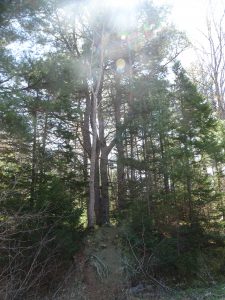
Entrance to patch of White Pine-dominated Old Growth forest by the Big Parking Lot. Photo on Apr 27, 2024.
We would be visiting 3 “patches” of Old Growth Forest. The first was a White Pine-dominated Old Growth stand located just off the parking lot; there we could view all of the Old Growth features cited in the handout [re: D: Patches of Old Growth].
We could also see evidence of two types of wind disturbance: Gap & Stand-replacing. Gap Disturbance was illustrated by the spaces where individual older trees had been uprooted or snapped off by wind and young trees are filling in the spaces. Stand-replacing wind disturbance was illustrated by the pronounced Pit and Mound Topography at the site; it is likely attributable to blowdown of a Mature/Old Growth forest during a hurricane in the 1800s; see Mature/OG Forest and Pit & Mound Topography for more info.
4. Big Parking Lot to the Beach
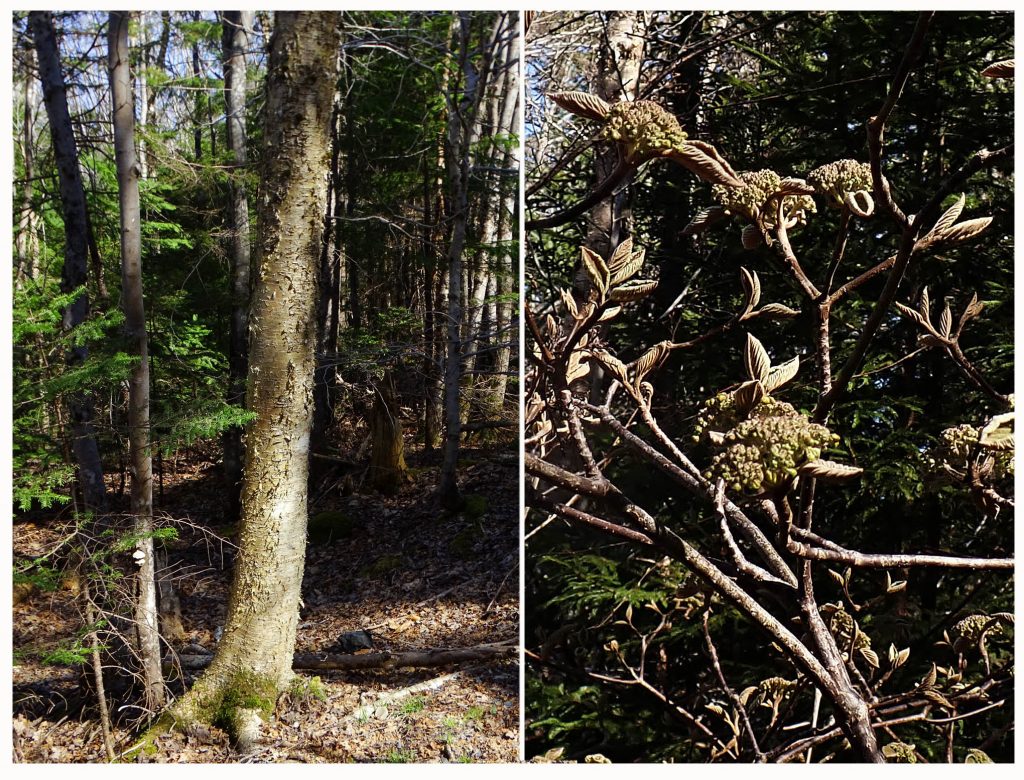
Left Yellow Birch, Right Hobble Bush by the road from the Big Parking Lot to the Beach.
Photos on Apr 27, 2024
En route we stopped near the bottom of the road where a stream emerges from the forest and goes under a culvert and thence through another 50 m or so of forest and finally empties into Sandy Lake. I used a pocket AP2 meter which I described as a “pollution monitor” to measure the temperature and electrical conductivity (a measure of the salt content) in the stream water, then I did the same on the shore of Sandy Lake. Earlier I had made the same measurements on a stream on the side of the road that goes from the Gate to the Big Parking Lot; it carries water from the adjacent forest. The results are shown below.
It’s notable that that water at the site with forest cover (middle pic) was the coolest. The two stream samples had very low EC. The much higher EC of the lake is due to streams entering the lake that drain developed areas & highways to the south and southwest of the lake. Measurements on Apr 27, 2024. See Links below for more info. about using such measurements to monitor pollution.
5. On to the Drumlin
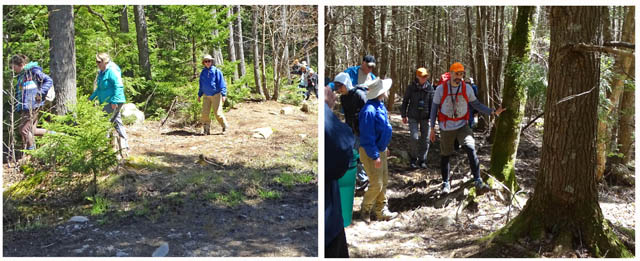
Left: Passing through the Old Cottage site. Right On the trail up the drumlin though hemlock dominated forest, we stop by an old epiphyte-covered beech tree.
From the beach, we walked northwest along shore until we reached an old cottage site; then we followed an old logging road/trail that took us up a drumlin through hemlock-dominated evergreen forest. We paused by an old, epiphyte-covered American Beech and Sean H talked about the some of mosses and lichens – see Sean H on lichens, mosses and liverworts for details. A little further on we saw examples of the “Wabanaki Forest Love Affair”.
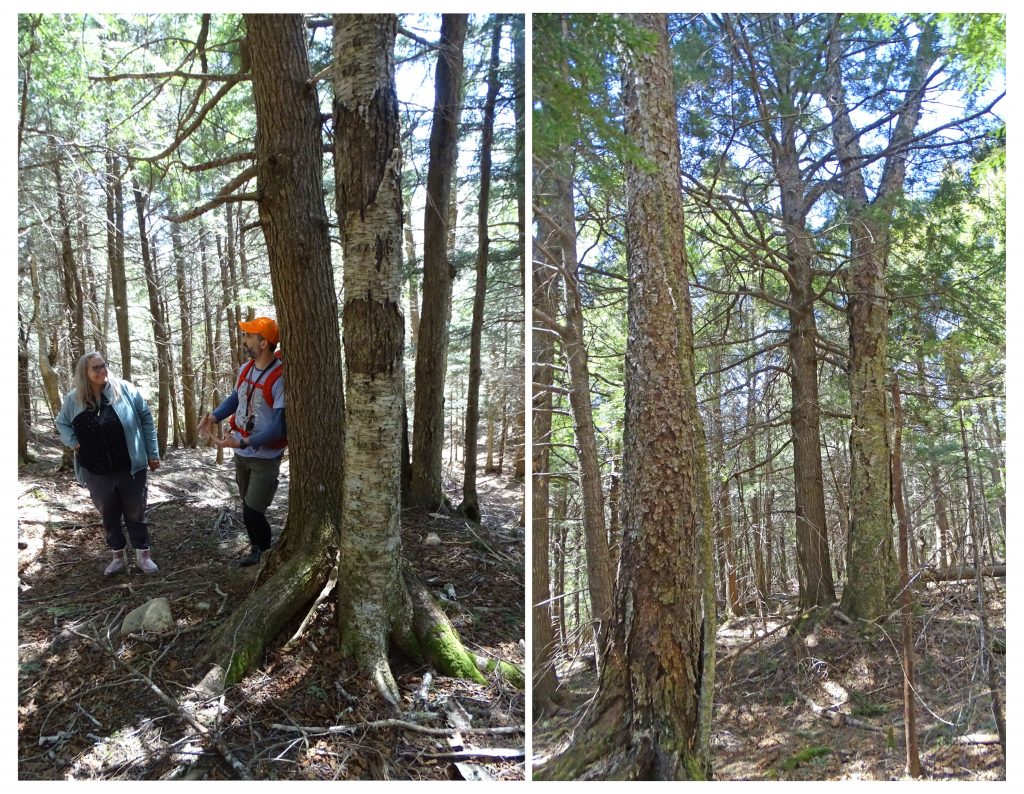
The “Wabanaki (Acadian) Forest Love Affair” between Eastern Hemlock and Yellow Birch. At left, embrace of the roots – the affair began on top of a mound, now eroded away exposing the embrace. Read more about the love affair here. At right, Hemlock & Yellow Birch emerge from a mound in a patch of Old Growth, hemlock-dominated forest.
View Group Photo (Several participants had gone back on their own at this point to keep on the 1-3 p.m. schedule so were not in the photo.)
6. The Old Hardwood-dominated mixed Forest
It was at this site that I wanted the group to spend most of its non-walking time. As we walked from the closed hemlock forest on the lake-side of the drumlin to the peak, the forest opened up with more hardwoods (not yet leafed-out), and as we descended on the other side, we were in a mixed, hardwood-dominated forest with patches of pure hardwoods. The most common hardwoods are Yellow Birch, Sugar Maple, and Red Maple, with lesser amounts of American Ash and White Birch; there is at least one Ironwood in this area. There are many Striped Maple that extend into the sub-canopy.
HOW OLD?
This stand didn’t quite qualify as “Old Growth”, rather it was classified as a “Mature Climax” stand when we did a formal assessment in 2017. That’s because the average age was 104 years (versus 125 years required for Old Growth under the 2012 Old Forest Policy).
However, the maximum age we observed was 141 years, in line with the maximum age at the Old Growth Pine and Old Growth Hemlock sites we visited; the maximum age and pronounced Pit and Mound topography at this site suggests that here, as at the other Old Growth sites we visited, there was a major blowdown of Old Growth forests circa 150-155 years ago. Read more under Mature/OG Forest, and Pit & Mound Topography.
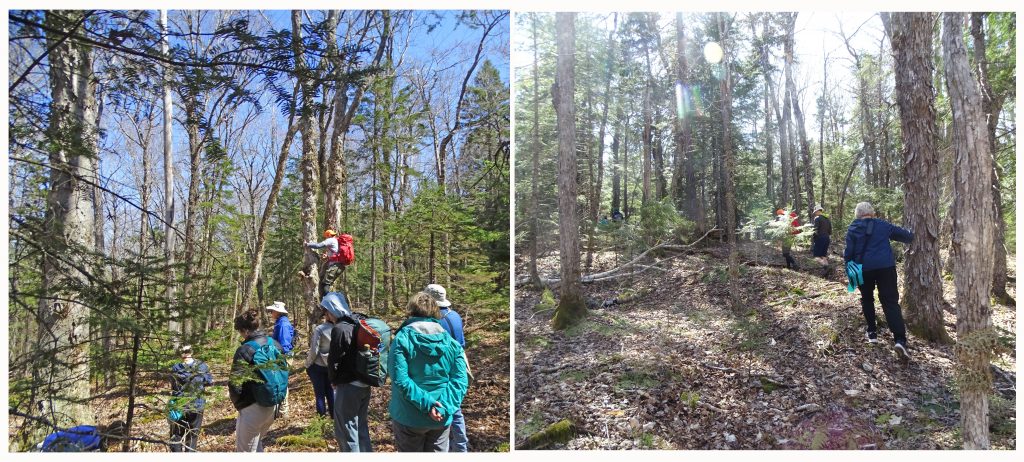
At left: Sean climbs a Sugar Maple to examine bryophytes. At right, a participant feels the shaggy bark of an old Red Maple. There was pronounced “Pit and Mound topography” at this site.
SUGAR MAPLE OR RED MAPLE?
We had some discussion of how you tell the difference between Sugar Maple and Red Maple at this time of year (and in winter) when there are no leaves, and the branches with buds are well out of reach. The bark can be a clue…e.g., very shaggy bark, as in the pic at right above) is characteristic of some but not all older Red Maples and is not seen on Sugar Maple. Sean commented that Old Sugar Maples are often covered by Tree skirt moss (Anomodon attenuates) at the base, but we didn’t don’t see it on the tree we were looking at (tree in the left pic above). Nearby there was a Red Maple readily identified as such as it had flowered and the flowers are red; such flowers were not on the tree we were looking at. (I knew this tree from previous visits when it was leafed out; it was definitely a Sugar Maple.)
FERNS
There was a lot of the evergreen Christmas Fern (Polystichum acrostichoides) on the forest floor, also the Intermediate Wood Fern (Dryopteris intermedia)
Sean commented that there are other quite rare fern species that occur in Nova Scotia’s old hardwood forests and that it’s a good time of year to pick out those that are evergreen (i.e. don’t die back in winter). An example: the Bronze Holly Fern (Polystichum braunii) which related to Christmas Fern – see the description of it on Minnesota Wildflowers, including comments on how it is distinguished from Christmas Fern.
WILDFLOWERS, MOSSES & LEAF LITTER
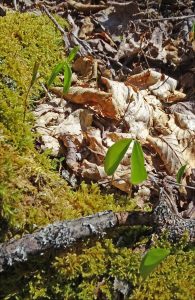
Seedling of Starflower (Trientalis borealis) at upper left, and two seedlings of Wild Lily of the Valley (Maianthemum canadense) at lower right of pic.
There were many Wild Lily of the Valley (Maianthemum canadense) at this site, just coming up. There will be more spring wildflowers later on. In general, hardwoods are good sites to find the now not-so-common “spring ephemerals’ such as Dutchman’s breeches (Dicentra cucullaria) and many of the generally more common “early summer forbs” such as the Wild Lily of the Valley we had seen and Bluebead Lily (Clintonia borealis). Later on we saw seedlings of Starflower (Trientalis borealis).
Sean commented that mosses and wildflowers on the forest floor in hardwood forests tend to occur on convex surfaces such as old rotting logs that slough off the abundant leaf litter. That might also help to explain something I had wondered about – why in general I had observed that where there is a pronounced pit and mound topography, we see wildflowers, ferns, mosses and tree-seedlings and bigger trees on the mounds rather than in the pits. I had speculated that better drainage on the mounds may be the cause, but the “leaf litter explanation” makes more sense – or perhaps both*
*Such explanations are ‘musings’ of the types naturalists often do; they are not definitive explanations which require formal scientific study. The idea that “More Wildflowers occur on mounds than in the pits because the mounds because there is less leaf litter” could be a hypothesis for a scientific study. We would begin by searching the scientific literature for what we know already about leaf littler and mounds, occurrence of wildflowers etc. I did a search for info. on “Pit and Mound, Leaf Litter Accumulation” and turned up right away a paper titled “Leaf litter effect on plant species composition of deciduous treefall pits” Susan Beatty and Owen Sholes in the Canadian Journal of Forest Research in 2011; it indeed provides some support for this hypothesis. Such is some of the fun of being a naturalist today – there is a wealth of scientific lit and other resources everyone can access and search readily to enhance our understanding of what we observe, also to help us be better observers, and to share our observations (re: iNaturalist).
On Identifying NS Ferns
– Common Ferns of Southwest Nova Scotia
Alain Belliveau, MTRI 2016
– Fern List by Leaf Divisions (Cuts)
Page on Ontario Ferns

